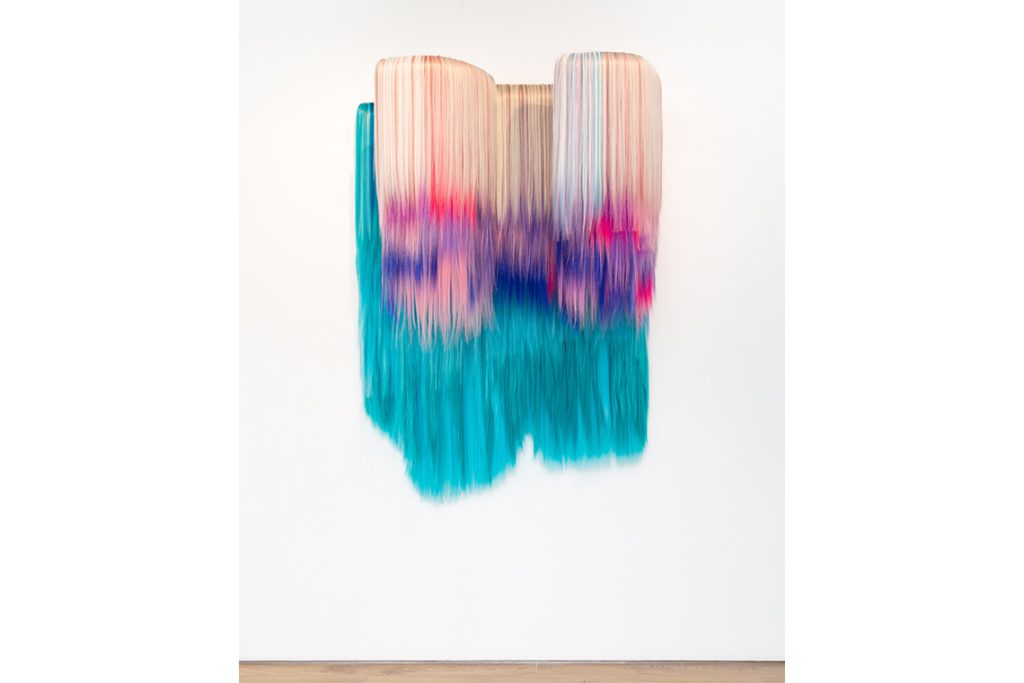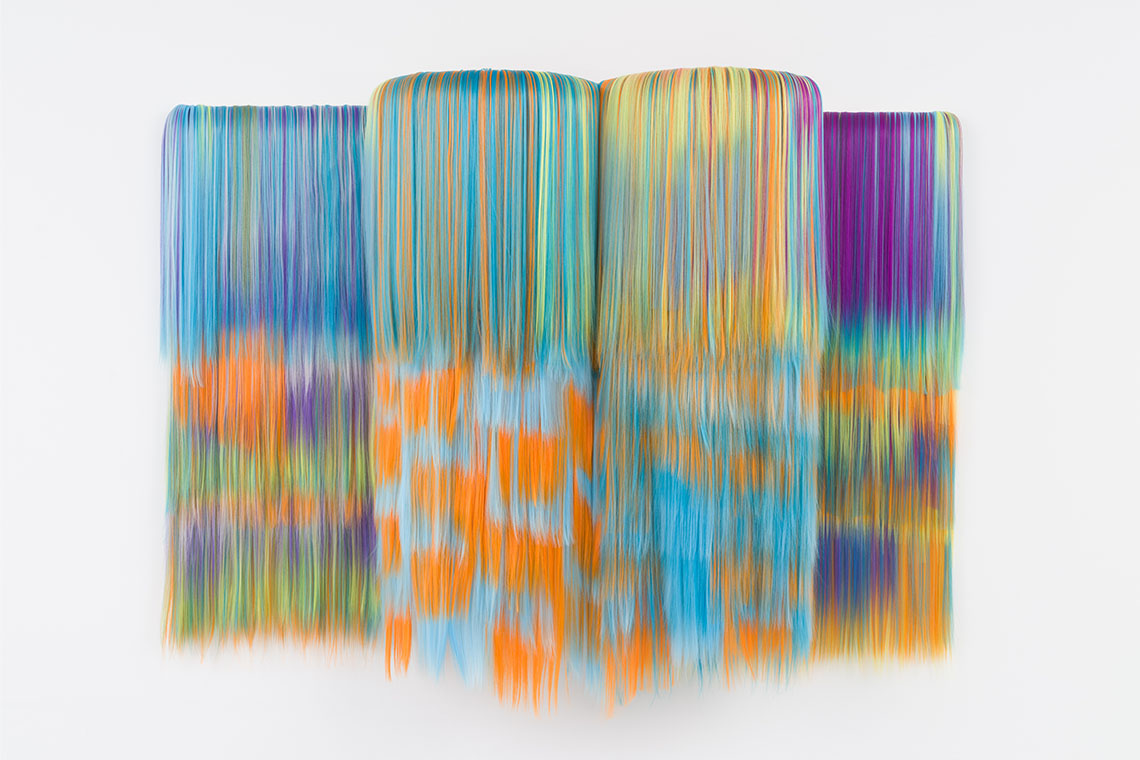Hiva Alizadeh’s solo exhibition at Kristin Hjellegjerde Gallery, Tower Bridge in London is a profoundly meditative take on hair, which assumes a magical and mystical meaning in the careful hands of the artist.
Hair is a multifaceted subject, simultaneously incredibly banal yet endlessly fascinating. Hiva Alizadeh seems to take the latter approach to the protein filaments that sprout all over the bodies of most mammals. His first solo exhibition at Kristin Hjellegjerde Gallery, Bare in the Garden, separates hair from the body, presenting a fantastical series of amorphous headlike shapes, scattered around the gallery’s walls in a rainbow-coloured display.
Tapping in particular into the spiritual significance of hair around the world, and inspired by the tradition of Persian carpet-weaving, the Iranian artist seeks to create a garden of sorts with his colourful sculptures, a haven that can be experienced not just as a physical space but also as a psychological realm, encouraging a sense of calmness, reflection and a deeper understanding of our ties with nature.
The quiet, dimly lit gallery is empty when I arrive, and as I stand at the entrance of the exhibition, I am immediately struck by the feeling of serenity which takes over me. Despite the primarily bright colours used by Alizadeh, there is something soothing about these manes of hair cascading from the walls. Visitors are encouraged to gently touch the sculptures, but I refrain. The strands feel inviting yet private as they rest on these inanimate beings, as if the synthetic hair is a curtain behind which someone or something is hiding.

Image courtesy of the artist and Kristin Hjellegjerde Gallery
Although these forms don’t feel threatening, they bring to mind some sort of mythical being, a creature which might jump off the wall and come to life at any moment, dancing like a performer in one of Nick Cave’s hair-covered soundsuits. Each ‘head’ of hair radiates with energy, the range of colours evoking a set of distinct emotions. No two are the same, some larger, some undulating, some shaggily cut… The colours seem to each encompass a particular emotion, underlining a realisation of how intuitive the attribution of certain feelings to particular colours is.
Alizadeh’s work is deeply inspired by the array of beliefs that surround hair, in myriad faiths and practices around the globe and which include hair as a source of cosmic connection in Hinduism and a tie to the divine and nature in Zoroastrianism. For Alizadeh, hair takes on a further dimension, that of a spiritual connection to something ‘beyond’. His artistic process is slow and precise, and sees him sewing each strand of synthetic hair onto a wooden frame – an act of meditation that, Alizadeh believes, translates its energy into the artwork. Here, we experience this methodical, measured process as an overall warm, enveloping feeling, but the calm is not uniform. The reverberations of each sculpture strike differently each time, evoking a range of mixed emotions and even prompting recollections of lost memories.
An electric pink, orange and purple sheet of hair gives us a burst of bright energy, while nearby a large-scale shape with varying shades of blue and purple is reminiscent of ocean waves. Behind a smooth outer layer lies a slightly frazzled and textured underlayer, a mane of multicoloured strands hiding beneath the surface, much like the hidden depths of deep waters. There is an enchanting element to the hair here, whereby a commonplace object becomes a place of mystery and fascination, like a secret garden.

Image courtesy of the artist and Kristin Hjellegjerde Gallery
Elsewhere, a dark pink iteration suddenly conjures up the warmth of love, its depths almost urging us to bury our faces in its embrace, like one might do with a lover, or as a child might do with a parent to seek comfort and reassurance. Of course, hair is deeply intimate. Everyone has it, yet the act of touching it is something usually only reserved for those closest to us. It can elicit feelings of connectedness if experienced through touch, or even embody the object of the feelings, like the locket of hair from a lover that someone might have kept once upon a time as a keepsake.
In many cultures, long hair is often the pride and joy of women, a personal asset to be admired but equally something that must only be seen under certain circumstances. Although the long tresses that Alizadeh creates seem to know no gender, their existence is free from the mortal realm where hair takes on such loaded meaning – they exist quietly and serenely in a sort of in-between space, almost acting as a gateway to a place beyond.
Such is the magic of Alizadeh’s work. It draws you in so discreetly that you don’t realise until you step back out of the gallery that you have been in a slightly otherworldly place, the artist’s garden of thought and feeling. It is rare to be invited into such quiet contemplation by a gallery space. I left wishing I could stay a little longer, these anonymous entities with colourful strands somehow feeling like trusted beings in the hands of Alizadeh, who has created a mystical sanctuary away from the hustle and bustle of the outside world.



